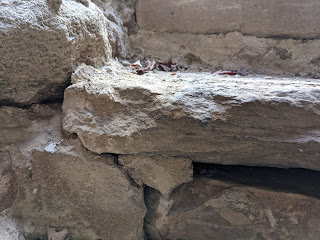And other stonework details...
Above: I realized I'd seen this face somewhere before.
Below: Somewhere Before
(Tamarack damage to the retaining wall - the Snake effigy for the entrance to the yard, but a strikingly similar "snake" - rather than a squared off end of a quarried stone.)
(Possibly a Tamarack grew here - some rotting wood remains.)
Rattlesnake-like capstone, to the right in the above photo:
When the sun hits it just right, like some petroglyphs, the rock art suddenly becomes very apparent,
realistic artistic details, comparable to an Eastern Timber Rattlesnake,
who often is associated with Great Serpents or Great Horned Serpents:

"Horned serpents are a type of mythological freshwater serpent common to many tribes of the eastern United States and Canada. Horned serpent legends vary somewhat from tribe to tribe, but they are usually described as huge, scaly, dragon-like serpents with horns and long teeth. Sometimes they move about on the land, but are more often found in lakes and rivers. The ubiquity of horned serpent stories in this region has led some people to speculate that they are based on a real animal (such as some sort of now-extinct giant crocodile.) However, in Native American myths and legends, horned serpents are usually very supernatural in character-- possessing magical abilities such as shape-shifting, invisibility, or hypnotic powers; bestowing powerful medicine upon humans who defeat them or help them; controlling storms and weather, and so on-- and were venerated as gods or spirit beings in some tribes. And unlike other animals such as crocodiles and snakes, horned serpents are not included in common Woodland Indian folktales about the animal kingdom. So it is likely that horned serpents have always been viewed as mythological spirits, not as animals, and that belief in them was simply very widespread in the eastern part of the country. Indeed, horned serpent mythology may trace back to ancestors of Eastern Native American tribes such as the Hopewell, Mississippian, and other mound-builder civilizations, as stylized serpent motifs have been found in their earthworks and artifacts which bear some resemblance to the horned serpents of historical Native American tribes."













No comments:
Post a Comment